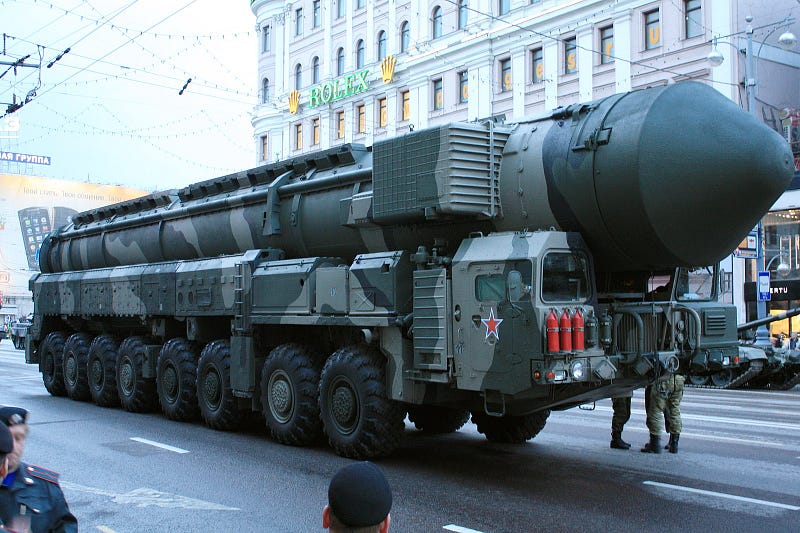The Diminishing Threat of Russia's Nuclear Arsenal in Ukraine
Written on
Understanding the Nuclear Landscape
In the context of ongoing tensions, particularly regarding Ukraine, the potency of Russia’s nuclear capabilities is under scrutiny. Putin’s nostalgic yearning for the Cold War era has led to aggressive posturing, including nuclear threats aimed at the West. This aggressive rhetoric has constrained NATO’s ability to support Ukraine fully, as the specter of a global nuclear conflict looms large. Interestingly, advancements in nuclear physics suggest that Russia’s nuclear arsenal may not be as formidable as once believed. But what does this imply for the situation in Ukraine and NATO's strategy?
To grasp why Russia’s nuclear capabilities might be compromised, we first need to examine the types of nuclear weapons in their arsenal.
Russia possesses the world’s largest nuclear stockpile, featuring 4,447 operational strategic nuclear weapons and 1,912 tactical nuclear weapons readily available. While the distinction between these weapon types is subtle, it significantly affects their deployment and operational logistics. Strategic nuclear weapons, such as Inter-Continental Ballistic Missiles (ICBMs), are designed for long-range destruction, capable of obliterating cities far away. The yield of these ICBMs ranges from 300 to 800 kilotonnes—sufficient to level entire urban areas like Washington, D.C.
Conversely, tactical nuclear weapons are smaller and can be launched from artillery or mobile missile platforms, with a maximum range of approximately 1,500 kilometers. They are intended for use in combat scenarios against military targets, hence their lower yield, which ranges from 1 to 50 kilotonnes.
The critical difference lies in the nuclear reactions that power these weapons. For a nuclear bomb to fit into a smaller shell or missile, it must be a pure fission bomb, which, while compact, is inefficient for producing yields exceeding 50 kilotonnes. Larger bombs utilize a thermonuclear design, which employs a small fission explosion to initiate a fusion reaction involving hydrogen isotopes, resulting in substantially higher yields.
Herein lies a significant issue for Russia.
Thermonuclear weapons rely on two specific isotopes of hydrogen: deuterium and tritium. Deuterium is naturally occurring and can be easily extracted from water, while tritium, being highly radioactive with a half-life of just 12.5 years, must be artificially produced. Tritium is generated by irradiating lithium in nuclear reactors, followed by a complex extraction process. This costly endeavor makes tritium one of the most expensive materials, priced at approximately $30,000 per gram.
So, why does this matter for Putin’s arsenal?
Thermonuclear weapons require a continuous supply of tritium to function effectively. Given its rapid decay, these weapons necessitate regular replenishment, which could pose a financial challenge for Russia. With an economy smaller than New York State’s and facing international sanctions, Russia must balance its military expenditures with the upkeep of its nuclear stockpile. Reports indicate that Russian soldiers may even have to purchase their own body armor due to budget constraints, which raises questions about the funding available for tritium production.
Consequently, it’s plausible that Putin is diverting resources to sustain military operations in Ukraine, potentially neglecting the maintenance of his nuclear deterrent. This raises the possibility that his nuclear threats could be more bluster than reality.
However, this does not entirely alleviate the threat to Ukraine. Russia’s tactical nuclear weapons do not require the expensive tritium refueling, making them viable options for immediate military action. While they may seem less daunting compared to their thermonuclear counterparts, it's essential to remember that the bomb dropped on Hiroshima had a yield of only 15 kilotonnes, and Russia's Iskander-K missile can deliver a payload of up to 50 kilotonnes.
We cannot definitively conclude that Russia is indeed underfunding its nuclear capabilities. Putin understands the importance of a nuclear deterrent and may prioritize tritium production. There’s also the possibility that sufficient tritium reserves exist to maintain operational readiness, although stockpiling a short-lived material seems illogical.
In summary, while it’s conceivable that Russia’s most potent nuclear weapons are becoming increasingly ineffective, there’s also a risk that they remain as lethal as ever. If it turns out that the threat of Russian nuclear escalation is diminishing, this could empower NATO to extend comprehensive support to Ukraine, potentially reversing the tide against Putin. However, if he is indeed prioritizing nuclear capability over military sustainability, it may indicate a willingness to drag everyone down with him. For the sake of global security, we can only hope for the former.
Chapter 1: The Nature of Russia's Nuclear Arsenal

Section 1.1: Strategic vs. Tactical Nuclear Weapons
Understanding the different types of nuclear weapons and their intended uses is crucial to assessing the current threat level.
Subsection 1.1.1: The Mechanics of Nuclear Weapons

Section 1.2: The Financial Strain on Russia's Military
The economic challenges faced by Russia may impact its ability to sustain its nuclear deterrent.
Chapter 2: Evaluating the Current Threat
This video explores how Russia's nuclear capabilities may have failed to deter Ukraine's invasion.
This video discusses the potential consequences for Putin if he crosses the nuclear threshold.